On the podium despite the duct tape
American Pro Jesse Thomas finished second at IRONMAN 70.3 Peru despite having to be duct taped into his race suit in T1. We had chat with him about this incident and much more.
Slowtwitch: Thank you for your time.
Jesse Thomas: Thanks for having me, Herbert!
ST: When did you arrive in Peru?
Jesse: Thursday morning at 2am.
ST: Do you have a routine of sorts when traveling to races abroad in terms of how much time you want to have at the venue before the race?
Jesse: It depends on the race. The more important and farther away it is, the earlier I go. 9-10 days before IM Lanzarote, for example, but I went to 70.3 Liuzhou just a couple of days before. For this race the timing worked to leave on Wednesday, arriving Thursday.

ST: Was the trip smooth and what do you typically do to entertain yourself during longer flights?
Jesse: Yeah, luckily it wasn't too bad, just a long day. Going from Bend is always a pain requiring with extra flights that make it long. But I made it, my bike made it, that's all you can really ask for.
I honestly work most of the flight most of the time. I take advantage of the fact that there’s either no Wi-Fi or crappy Wi-Fi to get Picky Bars stuff done without distraction. It’s the perfect time to deep dive into spreadsheets! Yay! If it's along a 9-hour flight I'll let myself watch a movie or I’ll read a book. I can't sleep on planes no matter what I do, so I just try to either work or relax.
ST: Did you feel well prepared?
Jesse: Yeah, I did. I feel like, similar to Lanzarote last year, my body is coming around really well. I knew going into Lanzarote last year (and Wildflower 3 weeks before) that I was in the best shape of my life based on my workouts. I didn't feel that way going into Kona last year. But right now, I feel like I'm closer to that 2016 pre-Lanzarote feel. My swim, bike and run numbers are in a similar spot.
ST: Do you much care who else is at the start or do you just focus on what you have to do?
Jesse: For sure I look at the field, but this race had little to do with trying to win a race, get points, or make prize money. The whole purpose of Peru was to test my fitness and practice some new things prior to Lanzarote – some heat and nutrition stuff, some tweaks to my position and bike equipment, etc. You always want to win, but that was secondary last weekend.
ST: On race morning when did you get up and what did you eat?
Jesse: I woke up 3 am local time (1 am “my time”), which is typical for me. 3-3.5 hours before race start. I ate my usual breakfast – oatmeal with peanut butter and a Need for Seed Picky Bar.
ST: Are you typically nervous before a race?
Jesse: Nowadays, not too much. Especially during a race like this that is really just a “practice” as much as anything else. For the ones I've really been focusing on (Ironmans, World Champs, etc), sure, I still get pretty nervous, but I've been doing this long enough now that there's a bit of a “job” feel to it, which is actually kind of nice. Getting nervous sucks.
ST: Talk about the swim.
Jesse: I never know how I'm doing in the swim, because I'm obviously never at or near the front, and most of the time I honestly assume I'm swimming terribly because it feels terrible! But I actually had a feeling I was having a decent swim on Sunday because I felt strong and smooth, and I led my pack most of the way. And coming out of the water just 80 seconds behind Andy is definitely a good swim for me.
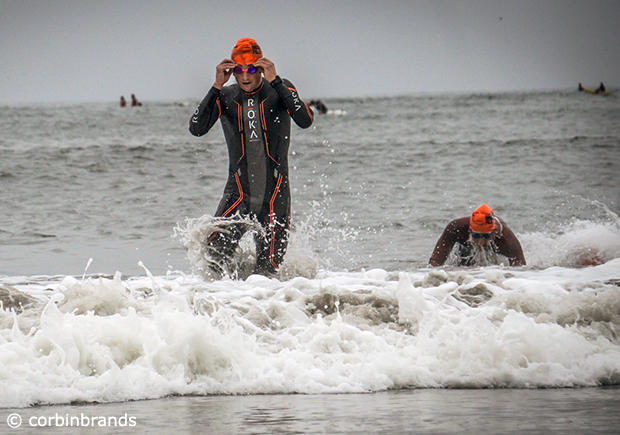
ST: When and how did the zipper break?
Jesse: I always swim with my kit rolled down around my waist because it restricts my shoulder motion too much. And it's always a pain to get it on wet and running into T1. But I've always been able to do it without too much of a problem. Sensing I had a solid swim, I think I tried to rush it a bit, and it got a little stuck on my right shoulder. Instead of rolling it down quickly and bringing it back up, I tried to force it, and the zipper just popped off the track and flew onto the ground.
ST: What went through your mind?
Jesse: “OH F$&K!” was the first thing I thought, and said, so sorry for that to anyone that was there. I knew immediately it was unfixable, so as I ran towards my bike I tried to remember if I had any pins for my race number, but I always use a race belt obviously so I didn’t have any. Then I wondered if I would get disqualified, because we literally had this big conversation at the pro meeting the day before about the bare chest rule. So I knew that I had to find a way to cover it up. So my mind just kind of immediately went to finding pins from the volunteers because I figured they might have some.
ST: Did race officials and volunteers near you get what you were looking for?
Jesse: They definitely knew I was freaking out and couldn't speak any Spanish! I don't think I was a dick or anything, but I obviously was pretty upset. I kept asking for pins and showing my kit wide open and pulling it together to show them what I was trying to do, but I wasn't sure anyone understood what I was saying. I saw the 6-8 guys behind me come grab their bikes and take off. I was right on the verge of either going with my kit wide open and expecting to get disqualified, or just calling it a day, which would have been massively disappointing given the time and money invested travel and the desire to test myself.
ST: How long did it take before the duct tape came out?
Jesse: It felt like forever, but looking at T2 times, it was probably only about a minute. A female volunteer came running up to me with this huge roll of standard silver duct tape and held it up saying something I didn’t understand. The man next to her understood what she was trying to do, and he grabbed my kit and held it together against my chest. Then I understood, so I held up my arms, and she wrapped it continuously around my chest 3-4 times, ripped the end with her teeth and smashed it down!
ST: Did they catch any of your chest hair when they duct taped you into your race kit?
Jesse: Haha, luckily I had trimmed my chest hair prior to the race. My new kit has a yellow top (so it’s cooler, hopefully) and when it gets wet my chest hair dominates straight through the yellow and you can barely read my sponsor logos. I'm cool being hairy, but if you can't even read the logos on my freaking jersey that's a problem! So anyway, it wasn't too bad, not nearly as bad as it would have been otherwise.
ST: Did it feel strange while riding?
Jesse: Yes, definitely. The biggest problem was how it constricted my breathing. I felt like I could take about a 70-80% breath. It wasn’t terrible, I could still breath, but it was an adjustment. About 20 miles in on the one small climb, I actually sat up and pulled it down a bit, which helped a little, but it was definitely a distraction.
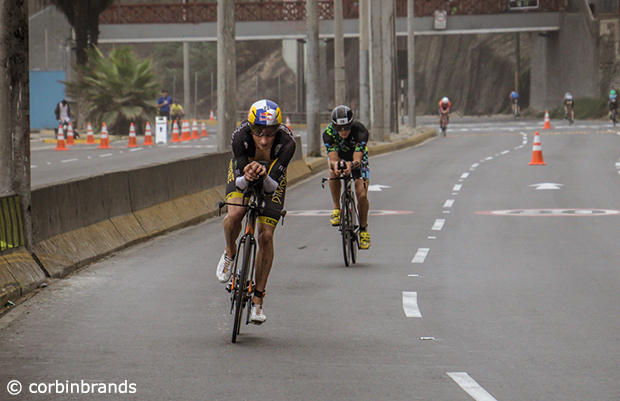
ST: Did you think the race was over or did you actually see what could still be done?
Jesse: At first I thought I probably wouldn’t last. It felt a slower and hard to breath, but I didn't know how much of that was in my head. So I honestly just focused on my Powertap numbers and thought, regardless of how fast I go, I can still try to put the work into the bike I was planning on. When I hit the first turnaround, I saw I was still 2 min back, but I'd passed my whole swim group so I knew I had to be pulling them back a bit. By the second turnaround I was 15 seconds closer, and started to believe I might be able to get myself back into the race. Plus, once I realized how ridiculous the whole things was, it kind of became a fun challenge – how fast can you ride with your chest completely duct taped? Ha!
ST: Nice bike split, eh? Maybe duct tape is the new aero?
Jesse: Hahaha. I have some awesome equipment from Dimond and Knight Composites, and when you pedal hard, it goes fast. My power was solid (~320W average), and I’ve made a lot of gains aerodynamically in the last year with lots of work on my flexibility and equipment tweaks. So it’s cool to see it paying off a bit, regardless of the duct tape!
ST: But you put on a t-shirt for the run?
Jesse: Yeah, I could tell that I was still showing a lot of my chest (and some of my stomach), and I really didn’t want to get DQed. On the bike you couldn’t see much because I was in the aero position, but on the run it would have been bad news. Plus, I honestly didn’t think I’d be able to breath while running upright. I was lucky I had my Descente warm up shirt in a pocket of my backpack in transition, so I stopped and grabbed it, undid the tape, rolled down my kit and just put on the shirt as I was running out of T2. Didn’t look that great, but it worked!
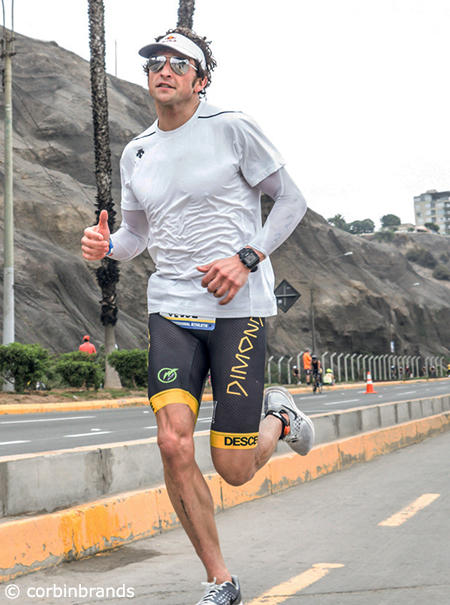
ST: What is the closest you came to Andy Potts?
Jesse: I got within about 21 seconds by my splits at mile 9 or so. I honestly thought I’d catch him as it seemed I was putting 6-8 seconds a mile on him at that point. But then my sartorius cramped (my typical cramping spot), and I lost about 15 seconds that mile. I knew it likely wasn’t going to happen at that point because of the extra time and my body was obviously pretty toasted, but I still managed to reel in a bit of time, so I’m proud for staying strong to the end.
ST: What did he say when he saw you at the finish?
Jesse: Oh nothing crazy, he said great job, solid racing, etc. We talked about our kids. He raced well, and he didn’t know what had happened. Most people didn’t see or notice the duct tape on the bike, they were only wondering why the hell I was running in a T shirt on the run – but they thought it was some kind of heat thing or something I was testing for Lanzarote, ha! Andy’s an awesome competitor and while it looks like I might have had him without the long transitions, I’m sure he would have raced differently if I’d caught him on the bike or the run – it’s too bad we didn’t have a chance to be side by side for more of the race because I think it would have been a good one.
ST: So what is next?
Jesse: I’m off to Ironman Lanzarote! Leave in about 10 days, race is in 3 weeks! I’m hoping to repeat obviously, I had arguably the best performance of my life there last year, so I’m not going in expecting to be that, but I’d like to do well. I’ll need a 1st or 2nd to “guarantee” I get into Kona without having to do another Ironman, so my work is cut out for me. I think I’m in a good spot physically, but the competition is really strong as well – the last 3 winners, plus Bart Aernouts who’s a consistent Kona top 10 guys and I think I’ve never beaten. Regardless, I’m excited to challenge myself again on that absolutely gnarly but beautiful course. I obviously love the adventure of this sport in addition of the competition, so it’ll be fun to see what happens.
ST: Why do you think the race does not attract more North Americans?
Jesse: Well, my guess is, for pros at least, it’s a combination of the difficulty/expense to get there and the relatively small prize purse and lowe Kona points. If you’re just trying to make money on the trip, it’s a tough sell. I’m in a lucky spot in my career where I’m supported well enough by my sponsors that I don’t necessarily have to be thinking only about how much money I make at each race. I can pick the races that suit my strengths, which ultimately, helps me succeed.
I also think in general it isn’t more popular because it is a freaking hard course. Likely the hardest Ironman bike course out there. It’s got almost 9000 feet of climbing and is crazy windy. Five hours is a solid pro bike split there. The run is hot as well, so it’s tough. But obviously that’s good for me, it gives me an extra 30-45 minutes of tough riding and running to make up my gap from the swim. I love the course, and the local support and the organizers and facilities at Club LaSanta are incredible. I’m excited to head back.
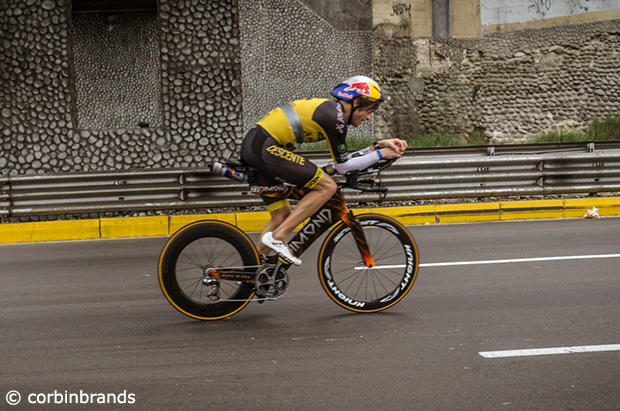
ST: You mentioned changes to your bike positions earlier. What changes to your position were made and how did it feel?
Jesse: Over the last year I’ve basically gotten longer and narrower on the bike, which has taken a lot of effort on loosening and strengthening my hips, glutes, and lower back, and shoulders. I also switched pedals and shoes, lowering my stack height, and I’m using the Giro Aerohead helmet, which is the first helmet that’s worked well for my varied head positions.
I’ve always been able to produce solid power on the bike, but my position has never been super aerodynamic because of back and neck inflexibility, so despite my size I typically have stronger bike splits on hillier courses, like Wildflower, Lanzarote, Wales, or even Oceanside. But I think it’s starting to come around, and it feels pretty decent. It’s always a work in progress, and the real tests will be my last couple of long workouts and Lanzarote of course.
ST: Whom do you work with in terms of bike fitting?
Jesse: I've worked with Paul Buick, who works with my coach Matt Dixon at Purplepatch Fitness. Paul taught me a ton about how to best use my power production strategically to maximize speed on a given course. And for the last year I've been working with Paraic McGlynn at Cyclologic in Scottsdale. I was originally connected to him by Bev Lucas at Knight Composites. I think Paraic does a great job of balancing tunnel data and aerodynamic expertise with individual physiology and common sense on the bike. It's always a balance of both in triathlon. I've made some solid gains with help from both of them.
ST: Is there anything else we should know?
Jesse: I think that’s about it. Just wanted to say a massive thanks to you Herbert for reaching out and being interested in telling this crazy story. And also thanks to the Marialuz and organizers and volunteers at 70.3 Peru for the help. Despite my crazy day, that was a well organized race and it’s worth checking out next year for those interested. Catch you guys later!
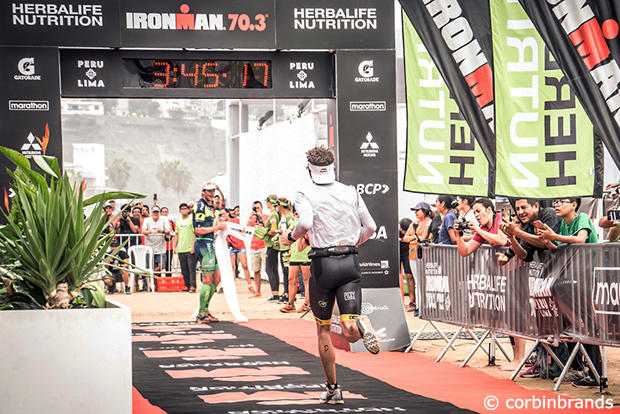
You can follow Jesse Thomas on Twitter via @jessemthomas and on Instagram via @jessemthomas
All images courtesy of Chris Corbin of corbinbrands.com


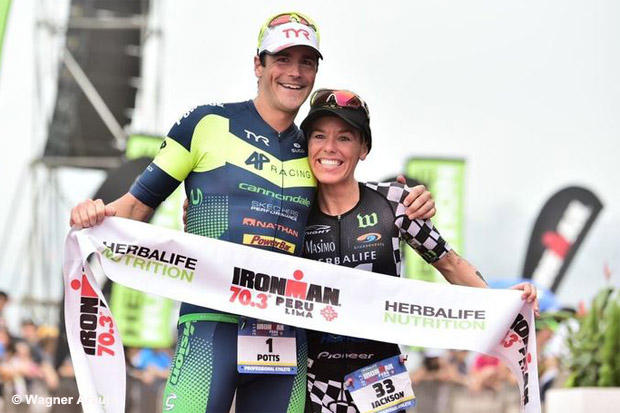
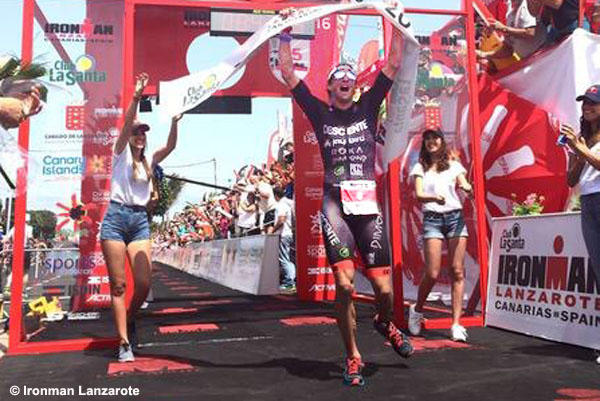
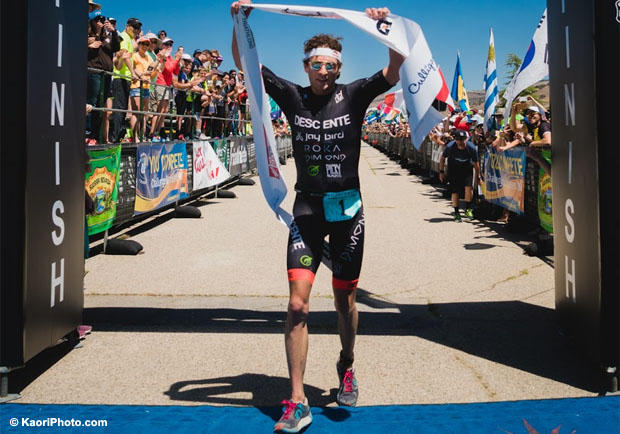
Start the discussion at slowtwitch.northend.network